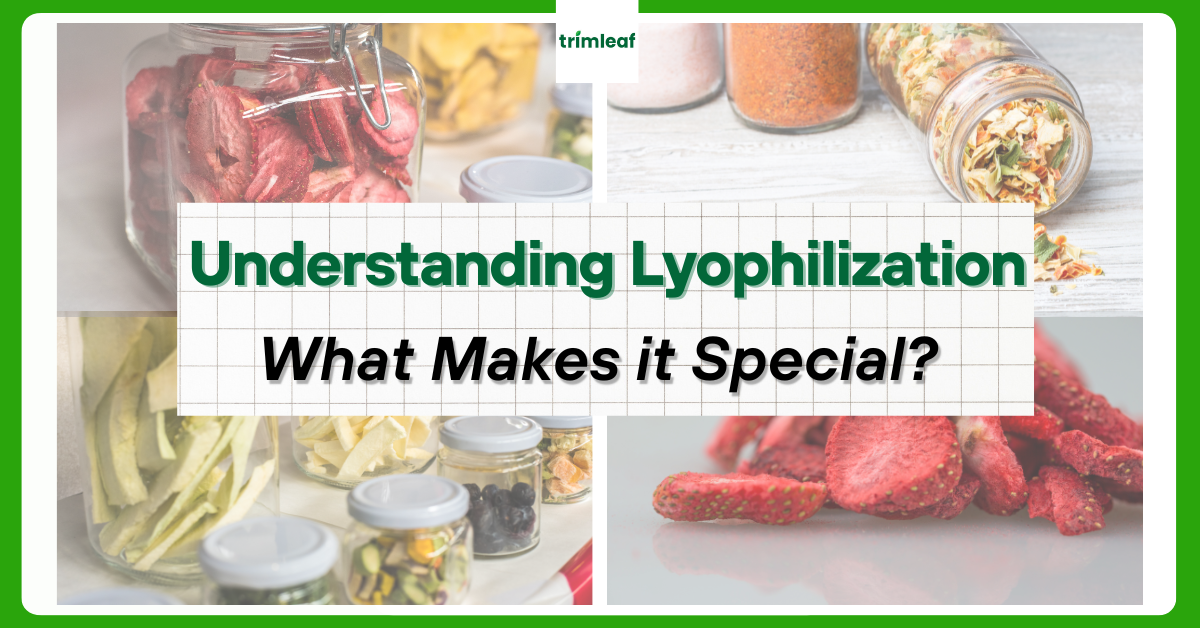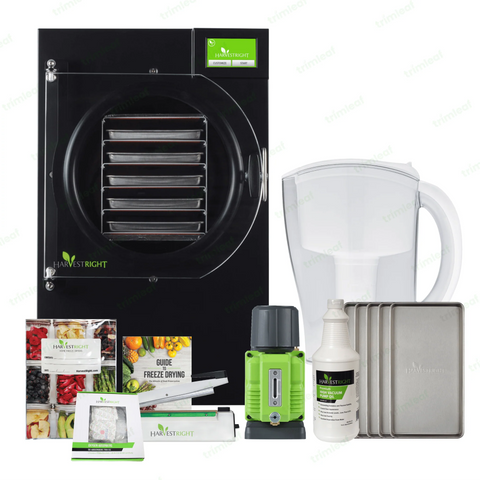
Lyophilization is a benchmark for preserving pharmaceuticals, food, and biological materials. But what sets lyophilization apart from other drying methods?
From its ability to retain the integrity of delicate substances to its long shelf life and stability, there are many reasons why lyophilization is the preferred method for drying sensitive materials. Lyophilization offers a meticulous approach to removal of moisture content, safeguarding materials' essence and composition with unparalleled precision.
Table of Contents
- What is Lyophilization?
- Lyophilization vs Conventional Preservation Methods
- The Lyophilization Process
- Problems To Avoid During Lyophilization
- Lyophilization Uses
- Benefits of Lyophilization
- Equipment and Considerations
- Factors Affect the Lyophilization Process
- Types of Lyophilization Equipment
- Conclusion
- Frequently Asked Questions About Lyophilization
What is Lyophilization?

Lyophilization, often called freeze-drying, is a specialized process used in controlled settings to preserve delicate materials. While freeze-drying is often associated with food preservation techniques, lyophilization is different. It is a precise method applied in scientific and industrial applications.
In scientific terms, lyophilization is defined as a process of removing water or solvent from a material through sublimation, bypassing the liquid phase.
This involves freezing the material and subjecting it to reduced pressure, allowing the frozen water molecules to transition directly from a solid to a vapor state without passing through the liquid phase. The result is a dry and stable product with minimal damage to its structure and composition.
How Does Lyophilization Compare to Other Preservation Methods

The Lyophilization Process
Lyophilization covers three phases, each crucial in preserving materials through controlled dehydration. Each phase contributes to efficiently lowering moisture content, allowing for better preservation. Understanding these phases of lyophilization allows for a better appreciation of the process involved in preserving delicate materials through lyophilization.
Stage 1: Freezing
The initial stage of lyophilization begins with subjecting the material to freezing temperatures, usually below the eutectic point. The eutectic point is the lowest possible temperature at which the components of a mixture can freeze together.
The material undergoes solidification at this phase, forming ice crystals within its structure. This freezing process effectively holds the water molecules in place, laying the groundwork for the subsequent dehydration process.
Stage 2: Primary Drying
After the freezing stage, the material enters the primary drying phase, where reduced pressure is applied. During this phase, the frozen water molecules transition directly from a solid to a vapor state through sublimation, skipping the liquid phase entirely.
The material is kept below its eutectic point and remains above its glass transition temperature to facilitate this sublimation process.
The glass transition temperature is when the material transitions from a rigid, glassy state to a softer, rubbery state. Controlling these temperature conditions allows moisture to be efficiently removed from the preserved material.
Stage 3: Secondary Drying
Once most ice crystals have sublimated during primary drying, the material enters the secondary drying phase.
In this stage, residual moisture is removed through desorption, wherein the remaining bound water molecules are expelled from the material's structure.
This process is typically achieved by elevating the temperature slightly above the glass transition temperature while maintaining low pressure, ensuring thorough dehydration without rehydration or structural damage.
Problems To Avoid During Lyophilization
During the lyophilization process, it is crucial to be aware of potential issues that may arise in order to ensure the successful preservation of your product. Here are some common issues that can arise during lyophilization and provide tips on how to avoid them:
- Formation of Large Ice Crystal - Large ice crystals can damage the structure of the material. To prevent this, it is important to control the drying time, drying conditions, and surface area of the material.
- Presence of Water in the Material After Primary Drying - To avoid this, it is crucial to monitor the temperature and pressure during the lyophilization process. Additionally, using an inert gas can help to remove any remaining water vapor.
Lyophilization Uses
Lyophilization delicately preserves materials through controlled dehydration, and it can be used across various industries, including:

Pharmaceutical: Lyophilization is extensively utilized in the pharmaceutical industry to stabilize and store vaccines. Lyophilization helps remove moisture from vaccine formulations to extend shelf-life, particularly in regions with limited access to refrigeration.
Many antibiotics are sensitive to moisture and heat, which can degrade their efficacy over time. Lyophilization offers a solution by preserving antibiotics in a dry state, ensuring their potency and efficacy throughout their shelf-life.

Biological: In microbiology and biotechnology, lyophilization is employed for the long-term preservation of cannabis or microbial cultures. By removing water from the samples, lyophilization prevents microbial growth and maintains the viability of cultures for extended periods, facilitating research and experimentation.
Biological samples such as tissues and enzymes are often lyophilized to maintain their structural integrity and biochemical properties. This preservation method enables researchers to store tissue samples for future analysis without compromising their quality.

Food Industry: Lyophilization is utilized in the food industry to preserve specialty ingredients and additives, such as spices, herbs, and flavorings. Preserving these high-value products help maintain their flavor, aroma, and nutritional content, ensuring superior quality and longer shelf-life.
Certain food products, such as gourmet coffee, fruits, and seafood, undergo lyophilization to retain their natural characteristics and enhance their shelf-stability.
This process allows for preserving delicate flavors and textures, making these products highly sought after in the culinary market.
Historical and Archival Preservation: Lyophilization is crucial in preserving historical artifacts, documents, and archival materials. It prevents deterioraiton and degration in historical artifcats, documents, and archival materials to ensure that future generations can appreciate and study it.
Benefits of Lyophilization
Lyophilization offers several distinct advantages across various industries. Its ability to preserve materials through controlled dehydration makes it a preferred method for preserving delicate materials, ensuring their integrity and usability for research, production, and preservation purposes.
Factors Affecting the Lyophilization Process

Temperature Control
Precise temperature control is critical throughout the lyophilization process to ensure optimal preservation of materials. The freezing phase requires carefully controlled temperatures to initiate solidification without causing damage to the sample.
During primary and secondary drying, maintaining the material at specific temperatures below its eutectic point and above its glass transition temperature is essential for efficient moisture removal and preservation.
Vacuum Pressure
Vacuum pressure plays a central role in lyophilization by facilitating the sublimation of frozen water molecules.
Lowering the pressure within the chamber creates an environment conducive to sublimation, allowing moisture to transition directly from a solid to a vapor state.
The choice of vacuum pressure and its application during primary and secondary drying stages directly impacts the efficiency and speed of the lyophilization process.
Sample Characteristics
The characteristics of the sample being lyophilized, such as its composition, size, and morphology, influence the process.
Variations in sample characteristics may necessitate adjustments to parameters, including freeze-drying protocols, shelf configurations, and cycle times, to achieve optimal results while preserving the integrity of the material.
Formulation
In lyophilization, a formulation is a combination of ingredients mixed with the material before freeze-drying. The chosen additives are important in improving the lyophilization processs and ensuring a successful outcome.
Formulation selection depends on the material itself, but when done correctly, it can significantly improve product stability, shorten drying times, and minimize the risk of collapse during the process.
Equipment and Considerations
The choice of equipment and meticulous attention to process parameters are paramount for achieving optimal results.
Understanding the types of lyophilization equipment available and the critical factors governing the process allows researchers and industry professionals to effectively harness its power to preserve delicate materials efficiently.
Before you start your freeze-drying adventure, consider these key factors to ensure you choose the right equipment for your needs:
- Shelf Space and Capacity: Freeze dryers come in various sizes, with capacities ranging from small batch models suited for individual use to larger units ideal for families or frequent preservation needs. Consider the amount of food you typically need to freeze-dry to determine the optimal size for your needs.
- Functionality: Think about what you plan to freeze-dry most often. Some models offer specialized features like pre-freezing options or faster drying cycles, which may be beneficial depending on your intended use.
- Maintenance: Freeze dryers require some level of maintenance, such as cleaning the chamber and pump oil changes. Research the specific maintenance requirements of different models to ensure you're comfortable with the upkeep involved.
These are just a few general considerations to keep in mind when choosing a home freeze dryer.
The ideal equipment will vary depending on your specific use case, whether you prioritize preserving your homegrown vegetables, creating long-lasting snacks for camping trips, or experimenting with gourmet freeze-dried cuisine.
Types of Lyophilization Equipment
Laboratory-Scale Equipment

Laboratory-scale lyophilizers are designed for small-scale experiments and research applications.
These compact units typically feature shelves or trays for holding samples, vacuum pumps, and condensers for removing moisture. They offer flexibility and precision for fine-tuning lyophilization parameters in controlled laboratory settings.
One example of a laboratory-scale equipment is the Holland Green Science Xiros Mikro Freeze Dryer.
Industrial Equipment

Industrial-scale lyophilizers, known as freeze dryers, are engineered for large-scale production and commercial applications.
These robust systems feature larger chamber capacities, multiple shelves or trays, and advanced control systems for efficiently processing bulk materials. Industrial lyophilizers have automated controls, allowing for high throughput and consistent results in industrial manufacturing environments.
If you're looking for industrial-grade freeze dryers, Harvest Right makes commercial scientific freeze dryers.
Home Freeze Dryer

A freeze dryer was once limited to industrial applications, but as people sought ways to preserve food for longer periods, freeze-drying has become increasingly accessible for home use.
Now, you can enjoy the benefits of freeze-drying in your own kitchen, preserving your harvest, creating delicious snacks, and exploring exciting culinary possibilities.
A prominent brand in the home freeze-drying space is Harvest Right, they are offering home and pharmaceutical freeze dryers.
Conclusion
Lyophilization is the most efficient preservation technique, given how it efficiently preserves the essence of materials without compromise. Its ability to meticulously remove moisture while preserving the integrity and functionality of materials has revolutionized industries, enabling researchers, manufacturers, and others to push the boundaries of preservation.
If you want to read more about lyophilization or freeze-drying, check the following:
What's the Difference Between a Freeze Dryer and a Dehydrator?
Harvest Right Freeze Drying Time Chart
How to Start a Freeze Dried Candy Business
Xiros Mikro vs. Harvest Right: Comparing Laboratory Grade Freeze Dryers
Frequently Asked Questions About Lyophilization
- How long does lyophilization take?
- Most samples may take 1-2 days (24-48 hours) to freeze dry in a lab, but some can take longer. The freeze drying process depends on various factors to determine the total time required.
- Does lyophilization remove all water content?
- No, lyophilization doesn't remove all the water content. It reduces it to a very low level, typically around 1-5%. This is enough to significantly increase shelf life and stability of the material.
- What are the drawbacks of lyophilization?
-
- Time-consuming process: Lyophilization can take several hours or even days, depending on the material and equipment.
- Expensive equipment: Lyophilizers are specialized machines that require a significant investment
- Not suitable for all materials: It's not suitable for all materials, particularly those with high solvent content or volatile components that may be lost during drying. Some materials may be sensitive to the freezing process or may not respond well to rehydration after freeze-drying.
- How does a freeze dryer work in lyophilization?
- A freeze dryer works by freezing the product, reducing the pressure to allow vapor to escape, and collecting the vapor on condenser ice crystals.
- What is the importance of lyophilization in the pharmaceutical industry?
- Lyophilization is crucial in the pharmaceutical industry for preserving pharmaceutical products, maintaining their efficacy, and extending their shelf life.
- What are some common parameters for the lyophilization process?
- The lyophilization cycle includes controlling factors such as drying temperatures, chamber pressure, and the amount of heat applied during the primary and secondary drying stages.
- Can I monitor the lyophilization process?
- Yes, modern lyophilizers offer real-time monitoring of temperature, pressure, and other parameters for optimal control.
- What happens to the removed water vapor?
- The vapor is captured by a condenser, typically cooled with liquid nitrogen, and converted back into ice.
- How do I rehydrate a freeze-dried product?
- Rehydration methods vary depending on the material. Common methods include adding sterile water or a specific solution.
- Can I lyophilize food at home?
- While technically possible with specialized equipment, it's not as common due to cost and complexity. Commercial freeze-drying offers better control and consistency.
- How does the freeze-drying process benefit biological materials?
- Freeze-drying offers several advantages for preserving biological materials like bacteria, enzymes, or tissues. Freeze-drying helps store biological materials like medicines or enzymes for years at room temperature. It removes water gently, keeping their structure intact and allowing them to work properly later. This also makes them lighter and easier to store and transport, and often eliminates the need for preservatives




